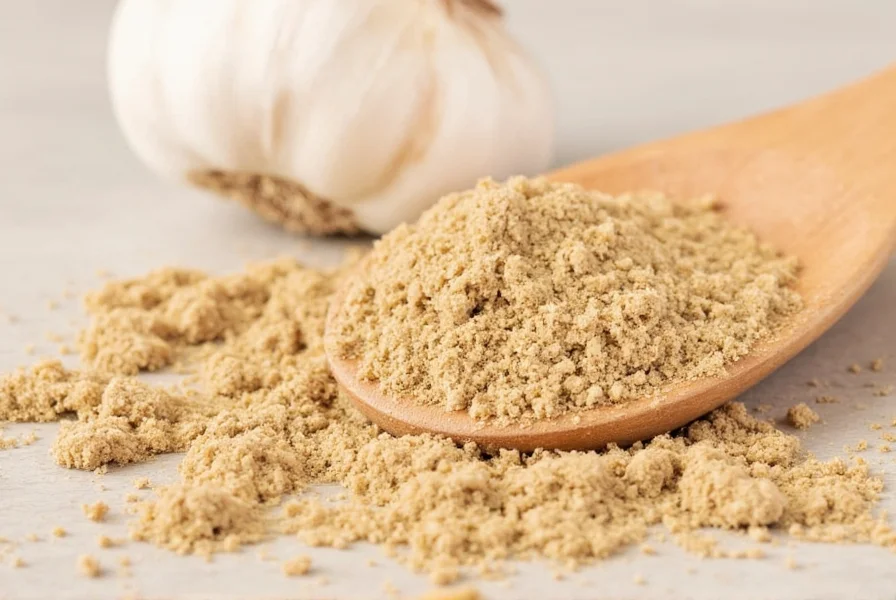Understanding garlic measurements can transform your cooking experience. Many home chefs face confusion when recipes call for fresh garlic cloves but they only have garlic powder in their pantry. Getting this substitution wrong can lead to bland dishes or overpowering garlic flavors that ruin your meal.
Garlic Powder to Fresh Garlic Conversion Explained
Garlic powder offers convenience but has a more concentrated flavor than fresh garlic due to the dehydration process. When converting between these forms, you need to account for both flavor intensity and moisture content differences.
| Garlic Form | Equivalent Measurement | Best For |
|---|---|---|
| 1 fresh garlic clove | 1/8 teaspoon garlic powder | Sauces, marinades, dressings |
| 3 fresh garlic cloves | 3/8 teaspoon garlic powder | Stews, soups, casseroles |
| 6 fresh garlic cloves | 3/4 teaspoon garlic powder | Rubs, spice blends, dry mixes |
| 10 fresh garlic cloves | 1 1/4 teaspoons garlic powder | Large batch cooking, commercial recipes |
Flavor Profile Differences
Garlic powder provides a more mellow, earthy flavor compared to fresh garlic's sharp, pungent bite. The drying process changes the chemical composition, resulting in less allicin (the compound responsible for garlic's characteristic aroma and health benefits). When substituting, consider these flavor differences:
- Fresh garlic delivers immediate pungency that mellows during cooking
- Garlic powder offers consistent flavor distribution throughout dishes
- Dried garlic lacks the moisture content of fresh cloves, affecting texture
- Garlic powder has a longer shelf life but gradually loses potency
Practical Substitution Guidelines
For accurate garlic powder to clove conversion in your recipes, follow these professional kitchen-tested recommendations:
When to Use Garlic Powder
Choose garlic powder when making dry rubs, spice blends, or recipes where even flavor distribution matters most. It works exceptionally well in:
- Dry marinades for meats
- Commercial food production
- Long-cooking dishes where fresh garlic might burn
- Situations requiring consistent flavor batch-to-batch
When Fresh Garlic Shines
Fresh garlic remains superior for dishes where:
- Immediate aromatic impact matters (like garlic bread)
- Texture plays a role in the final dish
- Maximum allicin content is desired for health benefits
- Recipes specify "freshly minced" or "crushed" garlic
Avoiding Common Substitution Mistakes
Many home cooks make critical errors when converting garlic powder to clove measurements. Prevent these common pitfalls:
- Don't use equal volumes - Garlic powder is significantly more concentrated
- Avoid adding garlic powder too early in cooking as it can become bitter
- Never substitute garlic salt for garlic powder without adjusting overall salt content
- Store garlic powder properly in airtight containers away from light to maintain potency
Advanced Conversion Techniques
Professional chefs sometimes use hybrid approaches for optimal flavor. Try these techniques when precision matters:
- For recipes calling for 4+ cloves, use 3/4 of the garlic powder equivalent plus one fresh clove for complexity
- Reconstitute garlic powder with a few drops of water before adding to wet ingredients
- When making garlic butter, use 50% garlic powder and 50% fresh minced garlic

Storage and Potency Considerations
Garlic powder gradually loses potency over time. For accurate garlic powder to clove conversion, consider these storage factors:
- Fresh garlic maintains peak flavor for 2-3 weeks at room temperature
- Garlic powder retains optimal potency for 6-12 months when stored properly
- Older garlic powder may require slightly increased measurements
- Test potency by rubbing a small amount between fingers - strong aroma indicates freshness
FAQ: Garlic Powder to Clove Conversion
Can I substitute garlic powder for fresh garlic in all recipes?
While you can substitute garlic powder in most recipes, it works best in cooked dishes rather than raw applications. For salad dressings, dips, or other uncooked preparations, fresh garlic provides superior flavor complexity that garlic powder cannot replicate.
How do I adjust recipes when using old garlic powder?
If your garlic powder has been stored longer than 6 months, increase the measurement by 1/16 teaspoon per clove equivalent. Test the flavor as you cook and adjust accordingly, as potency diminishes significantly after one year of storage.
Why does my garlic powder substitution taste different than fresh garlic?
Garlic powder has a more earthy, mellow flavor profile compared to fresh garlic's sharp pungency. The drying process changes the chemical composition, resulting in less allicin. For closer flavor matching, add a pinch of onion powder or a small amount of lemon juice to brighten the flavor.
What's the difference between garlic powder and garlic granules?
Garlic granules are coarser than garlic powder and have slightly less concentrated flavor. When substituting granules for fresh garlic, use 3/16 teaspoon per clove instead of 1/8 teaspoon for powder. Granules work better in dry rubs where texture matters.











 浙公网安备
33010002000092号
浙公网安备
33010002000092号 浙B2-20120091-4
浙B2-20120091-4